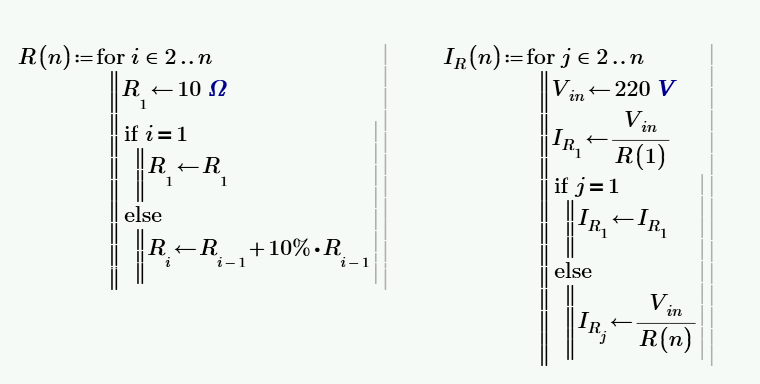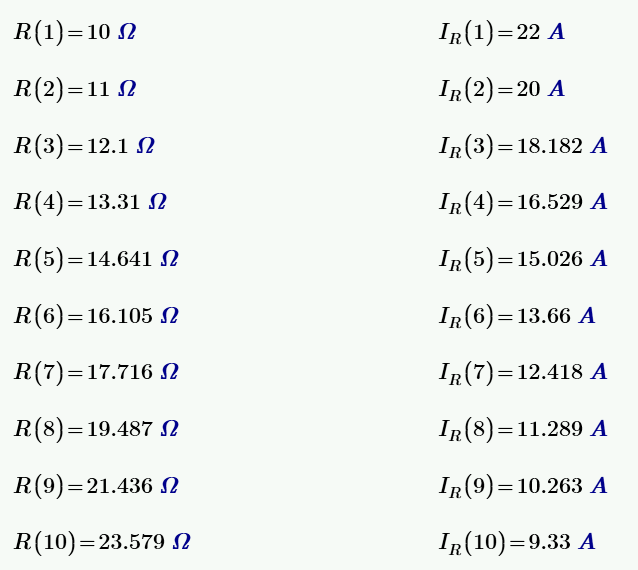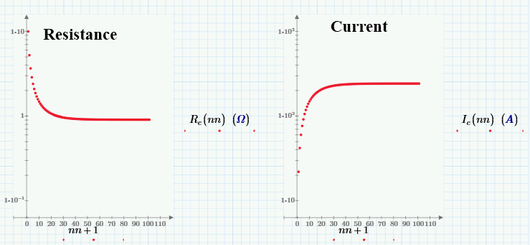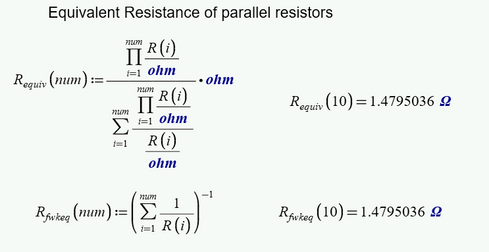Community Tip - When posting, your subject should be specific and summarize your question. Here are some additional tips on asking a great question. X
- Subscribe to RSS Feed
- Mark Topic as New
- Mark Topic as Read
- Float this Topic for Current User
- Bookmark
- Subscribe
- Mute
- Printer Friendly Page
Mathcad Community Challenge September 2022 - Resistors in Parallel
- Mark as New
- Bookmark
- Subscribe
- Mute
- Subscribe to RSS Feed
- Permalink
- Notify Moderator
Mathcad Community Challenge September 2022 - Resistors in Parallel
This month’s challenge is related to electrical engineering. We have a simple circuit with an electrical potential of 220 Volts. Initially we have a single 10 Ohm resistor. Then we add a second resistor in parallel, with 10% higher resistance. Then we add a third resistor in parallel, with 10% higher resistance than the previous resistor. And so on.
- Calculate the current in the circuit for the single resistor case.
- Calculate the resistance of each additional resistor and current through each resistor for 2, 3, 4, 5, and 10 resistors in parallel.
- Can you write a function or program that calculates the resistance of each resistor and current through each resistor for n resistors in parallel?
These calculations are fairly straightforward, so it will be interesting to see what tools – vectors, matrices, loops, plots, charts, etc. – that you use to solve the problem. As always, how you document your calculations is important as your worksheet will be visible to the community.
Here is an example of three resistors in parallel, as drawn in Creo Schematics:
Find the Mathcad Community Challenge Guidelines here!
- Labels:
-
Mathcad Challenge
-
Puzzles Games
- Mark as New
- Bookmark
- Subscribe
- Mute
- Subscribe to RSS Feed
- Permalink
- Notify Moderator
Hello,
My first try (Mathcad Prime 7):
- Mark as New
- Bookmark
- Subscribe
- Mute
- Subscribe to RSS Feed
- Permalink
- Notify Moderator
Here's a solution in Prime 4 express.
Luc
- Mark as New
- Bookmark
- Subscribe
- Mute
- Subscribe to RSS Feed
- Permalink
- Notify Moderator
Calculating resistance and current for each resistor is simple.

Calculating resistance and current for the network is more pertinent:
Prime Express 4 attached
- Mark as New
- Bookmark
- Subscribe
- Mute
- Subscribe to RSS Feed
- Permalink
- Notify Moderator
I like to use Mathcad symbolics for insights into how to derive solutions. My final and generalized answer for the total resistance equation is:
The complete solution is attached.
- Mark as New
- Bookmark
- Subscribe
- Mute
- Subscribe to RSS Feed
- Permalink
- Notify Moderator
In your Mathcad sheet, you write,
When then the resistance approaches zero.
However, Fred, ppal and others show the total parallel resistance is
- Mark as New
- Bookmark
- Subscribe
- Mute
- Subscribe to RSS Feed
- Permalink
- Notify Moderator
Good catch. I stand corrected. I was not considering that the the resistors are increasing in value. Before stating so, I should have taken the extra step to derive the limit as you did,
Bob
- Mark as New
- Bookmark
- Subscribe
- Mute
- Subscribe to RSS Feed
- Permalink
- Notify Moderator
- Mark as New
- Bookmark
- Subscribe
- Mute
- Subscribe to RSS Feed
- Permalink
- Notify Moderator
- Mark as New
- Bookmark
- Subscribe
- Mute
- Subscribe to RSS Feed
- Permalink
- Notify Moderator
- Mark as New
- Bookmark
- Subscribe
- Mute
- Subscribe to RSS Feed
- Permalink
- Notify Moderator
- Mark as New
- Bookmark
- Subscribe
- Mute
- Subscribe to RSS Feed
- Permalink
- Notify Moderator
- Mark as New
- Bookmark
- Subscribe
- Mute
- Subscribe to RSS Feed
- Permalink
- Notify Moderator
Hi @ttokoro , would you care to please attach your worksheet? Not just screenshots?
- Mark as New
- Bookmark
- Subscribe
- Mute
- Subscribe to RSS Feed
- Permalink
- Notify Moderator
- Mark as New
- Bookmark
- Subscribe
- Mute
- Subscribe to RSS Feed
- Permalink
- Notify Moderator
Here's another incarnation, using recursion to generate the resistor values:
Prime 4 attached, works also in Prime Express.
Luc
- Mark as New
- Bookmark
- Subscribe
- Mute
- Subscribe to RSS Feed
- Permalink
- Notify Moderator
- Mark as New
- Bookmark
- Subscribe
- Mute
- Subscribe to RSS Feed
- Permalink
- Notify Moderator
Some nice analyses, indeed.
But... don't do this at home!
Even just the first 10 ohm resistor is dissipating 4840 Watts, and the others not much less! Gonna get toasty in there!
- Mark as New
- Bookmark
- Subscribe
- Mute
- Subscribe to RSS Feed
- Permalink
- Notify Moderator
Yeah, don't try this as home, Or anywhere else but as an exercise.
(We could argue that you deserve the burnt fingers and having to sweep up the charred remains, but . . .)
Here's your sign!
- Mark as New
- Bookmark
- Subscribe
- Mute
- Subscribe to RSS Feed
- Permalink
- Notify Moderator
- Mark as New
- Bookmark
- Subscribe
- Mute
- Subscribe to RSS Feed
- Permalink
- Notify Moderator
- Mark as New
- Bookmark
- Subscribe
- Mute
- Subscribe to RSS Feed
- Permalink
- Notify Moderator
- Mark as New
- Bookmark
- Subscribe
- Mute
- Subscribe to RSS Feed
- Permalink
- Notify Moderator
- Mark as New
- Bookmark
- Subscribe
- Mute
- Subscribe to RSS Feed
- Permalink
- Notify Moderator
Please attach the file.
- Mark as New
- Bookmark
- Subscribe
- Mute
- Subscribe to RSS Feed
- Permalink
- Notify Moderator
Sure, happy to attach the file. But NOTE: there's no Mathcad work here! The solution is so simple that's not needed. I simply used Prime as a typing pad.
The only thing clever is realizing that it's trivial if viewed from the standpoint of the conductances, and then representing the summation of the conductances and resolving that series with an expression we all remember from high school. I marked that line with *** in the attached mcdx file.
- Mark as New
- Bookmark
- Subscribe
- Mute
- Subscribe to RSS Feed
- Permalink
- Notify Moderator
- Mark as New
- Bookmark
- Subscribe
- Mute
- Subscribe to RSS Feed
- Permalink
- Notify Moderator
Yep, that's good with the OP's original parameters.
- Mark as New
- Bookmark
- Subscribe
- Mute
- Subscribe to RSS Feed
- Permalink
- Notify Moderator
- Mark as New
- Bookmark
- Subscribe
- Mute
- Subscribe to RSS Feed
- Permalink
- Notify Moderator
Very nice calculation! Well done!
Not criticisms, just comments:
1) Not sure why you changed the default ORIGIN. If that's your default choice, okay; but understanding somebody else's sheet may be confusing,
2) (And, IMHO opinion, more important) Don't divide out units in functions unless you absolutely must! Your equation for total resistance stripped the units. (I know why,) But you didn't need to, and the equivalent equation is simpler and easy to visualize:
Welcome to Mathcad!
- Mark as New
- Bookmark
- Subscribe
- Mute
- Subscribe to RSS Feed
- Permalink
- Notify Moderator
Fred:
Thanks for the comments.... I should have simplified the equation a bit!
With regards to the ORIGIN change... the thought was that I wanted there to be no R0... R1 was to be the first resistor. In playing around with the code though, it appears it works a bit differently that I had understood. Working on that...
thanks
Adam
- Mark as New
- Bookmark
- Subscribe
- Mute
- Subscribe to RSS Feed
- Permalink
- Notify Moderator
Opting to make a work sheet that uses "for" loops, is easy for a student to follow, and is scalable.



































